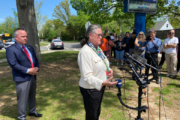The air we breathe in the D.C. area has been very unhealthy, according to a new report by the American Lung Association.
The 2025 “State of the Air” report found that the air quality in the region has dropped from a “C” grade in pollution in 2024 to an “F” in one key area.
“We’re going in the wrong direction,” said Dr. Amit “Bobby” Mahajan, a spokesperson for the American Lung Association. “We need to make concerted efforts to in terms of improving our environment.”
The report looked at air quality data from 2021 through 2023 and found that smoke from the wildfires seen out west and in Canada in 2023 added on to the already problematic smog conditions in D.C. region.
When it comes to ground level ozone, or “smog,” the area, which also includes parts of West Virginia and Pennsylvania, ranked as the 36th worst in the nation with a score of “F.” That ranking was based on the area’s worst county, Baltimore County, which had an average number of 7.5 unhealthy days a year.
In last year’s report, Baltimore County ranked 44th worst with 4.3 unhealthy days a year.
Mahajan, who is also the medical director of the Inova Interventional Pulmonology and Complex Airway Disease Program, said the area ranked second-worst when it came to ozone pollution in the Mid-Atlantic region, falling only behind the New York City area.
With short term spikes in particle pollution, the region ranked 53rd worst for unhealthy days, with 3.7 days a year. D.C. dropped to an “F” grade from last year’s “C” grade with 1.7 unhealthy days per year.
Nationwide, the numbers were not great either as 156 million people, or 46%, of the population are living under unhealthy levels of air pollution.
Mahajan said for people without underlying lung diseases, the conditions may have caused them to notice more aromas, such as soot, in the air. For people with illnesses such as asthma and emphysema, the situation can be much more dire.
“For people who already have compromised breathing because of these underlying diseases, it can make them more short of breath, and frankly, it can lead to hospital admissions and ER visits because their shortness of breath is exacerbated by the different pollutions throughout the air,” Mahajan said.
Exacerbations of their conditions can result in people who work outdoors being unable to work. It can also lead to heart attacks, strokes, preterm births and low birth rates.
“We also know that exposure to excessive amounts of pollution increases your risk of lung cancers,” Mahajan said.
While pollution is hard to control, what can be done is work to lessen gases that lead to smog, by developing cleaner cars and public transportation, according to Mahajan.
“Trying to avoid or trying to get around the DMV without a car can be challenging, but I think that at least being conscious of those things will allow us to, at least on a local level, talk about it,” he said.
He encourages people to pay attention to air quality, and make changes on days when levels are high.
“Taking a look and getting an idea of what the ozone level on the air, healthiness level is, on a daily basis can tell you how much I need they need to go out on those days, or if they need to protect themselves with a high particulate mask,” he said.
Mahajan also said the conditions should also result in people at high risk of getting lung cancer being screened more often. Those who qualify for the screening are people with certain lung conditions, and those who have smoked for long periods.
“What we want to be able to do is do these lung cancer screenings on a regular basis on this high-risk population, so we can reduce the mortality,” he said.
He also said one thing helping in the lung cancer fight is more effective options for treating it, if it’s caught early.
“If we diagnose lung cancer early through lung cancer screening, the survival rates of stage one and two disease are close to 90% at five years, versus about 15% at five years if we diagnose it later in stage three or four,” he said.
Get breaking news and daily headlines delivered to your email inbox by signing up here.
© 2025 WTOP. All Rights Reserved. This website is not intended for users located within the European Economic Area.







